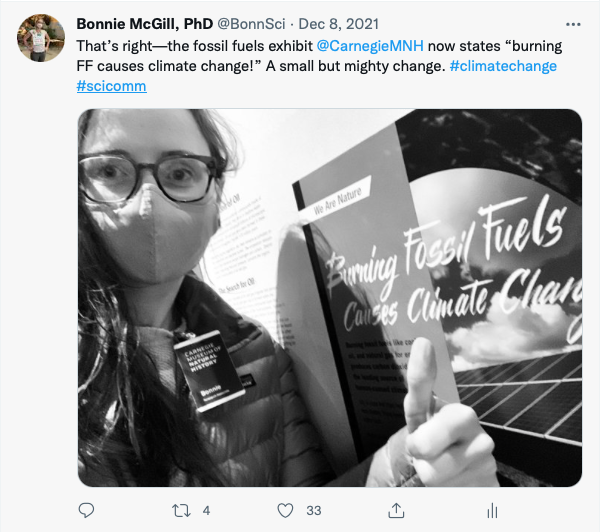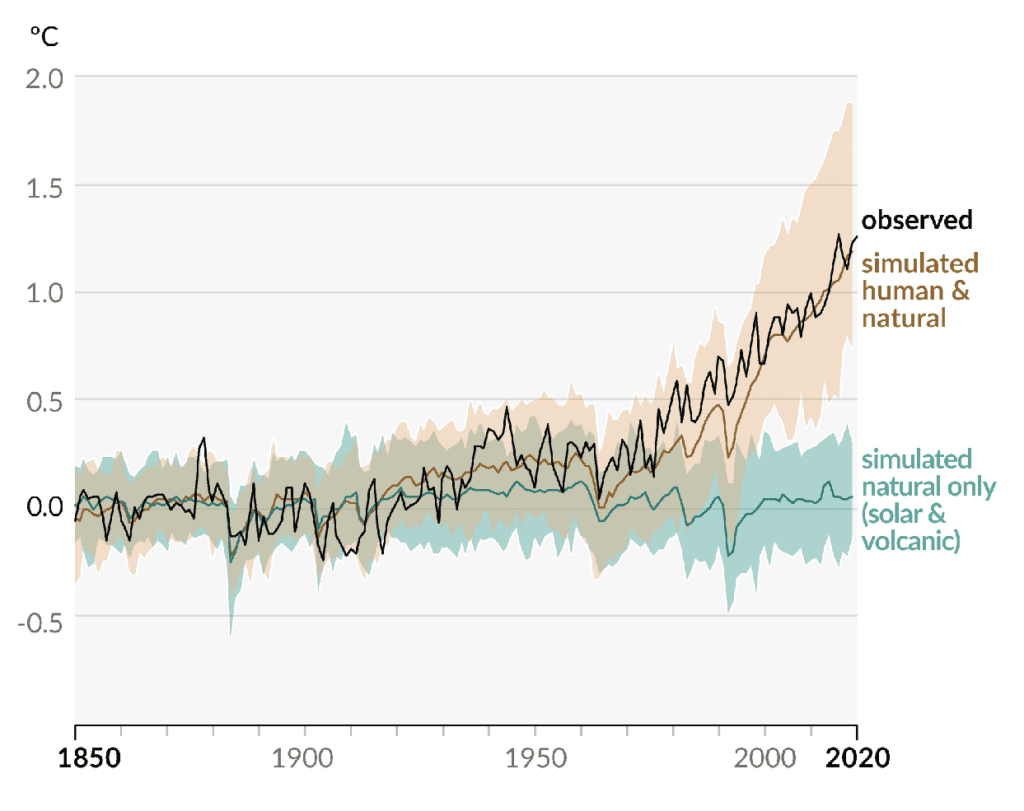by Dr. Bonnie McGill
If you’ve visited the museum recently you may have noticed some new orange labels throughout the exhibit halls. These are part of an innovative visitor experience titled, We Are Nature: A New Natural History. I helped write the label you’ll find in Benedum Hall of Geology next to the oil and coal specimens. Its six-word headline reads “Burning fossil fuels causes climate change”.

This is an important exhibit update. When looking at a big chunk of coal, it’s hard to not think about climate change. Fossil fuel combustion is the leading cause of climate change. For example, from 2010-2019, burning fossil fuels (coal, oil, natural gas) accounted for 81-91% of total human-caused CO2 emissions (IPCC AR6 WGI 2021 ch 5 p 6). Over that same time period the measured global average temperature was 1.6-2.2 oF (0.9-1.2 oC) warmer than the pre-industrial global average temperature. This increase cannot be explained by natural processes (such as changes in solar irradiance or volcanoes), which actually decreased the temperature by 0.2 oF (0.1oC), according to the Intergovernmental Panel on Climate Change (IPCC) (IPCC AR6 WGI 2021 ch 3 p4).
While the museum has understood the science of anthropogenic climate change for many years, adding these new labels explicitly linking fossil fuels to climate change has created opportunities for new discussion and questions about what scientists know and what they don’t know. To help address these questions, the CMNH Natural History Interpreters have been working with the Climate and Rural Systems Partnership (CRSP) to bolster their climate conversation skills and climate science knowledge. One tool we at CRSP have developed with our regional network of community partners is a climate change myth busting resource that breaks down some of the most commonly repeated myths about climate change.
Let me show you how the climate change myth busting resource works. For example, here is one myth we hear a lot:
“The climate has always changed, therefore this is natural.”
The guide provides three types of information to address the myth:
1. The science bottom line
Yes, the climate has always changed. This time it’s different. It’s more rapid than past changes and it can only be explained by human activity.
2. The science in more detail (not a script, simply background information)
Past climate changes were dominated by naturally occurring cyclical changes in the Earth’s orbit and axis. Volcanoes and asteroid impacts have also changed the chemistry of the atmosphere and, thus, Earth’s temperature in the past. These forces continue to have effects. Today natural forces contribute a -0.2 oF effect on modern day global warming, which cannot explain the warming observed today. Human activities contribute a net increase of 1.4-2.3 oF. This means humans are having a 7- to 11-fold greater impact on global temperature than non-human forces of nature.
Scientists have 99.999% certainty that current climate change is human-caused. As the IPCC says “its unequivocal”. One of the strongest lines of evidence comes from comparing observed (past) global average temperatures with projections from climate models for the same time period. Only the climate models that include heat-trapping gas emissions from human activities match the observed temperatures (see plot below). Climate models that include only natural forces of climate change do not match observed changes in global temperature.

Additionally, fossil fuels are the only source of carbon (representing millions of years of plant-stored carbon) large enough to explain the observed increase in atmospheric CO2. The carbon isotopes in the CO2 match the carbon isotopes of fossil fuels.
3. Ideas for moving the conversation toward solutions
Recognize that the person engaging in conversation seems to agree that the climate IS changing–shared agreement is vitally important.
It’s true the Earth’s climate has always changed—our planet has had ice ages and Hothouse periods caused by natural changes in the Earth’s orbit and axis, changes in solar irradiance, and volcanoes. This time it’s different. Natural cycles, solar energy, and volcanoes alone are not enough to explain the increase in atmospheric CO2 concentrations and Earth’s temperature. Human emissions of greenhouse gases, primarily from the burning of fossil fuels, do explain the increase in CO2 and temperature.
Knowing it is human-caused means it can be human-solved! It is important that we’re on the same page about the cause of climate change, so that we can develop effective solutions. For example, you could say, “Perhaps you might be interested in learning more about climate solutions, many of which improve other conditions too like our health?” For solutions to talk about see Project Drawdown. Transitioning to renewable energy will benefit air and water quality and human health.
Climate change information added to galleries, and training staff on climate science and techniques for talking about it in friendly ways, are just a few examples of how the scientists, educators, and exhibitions team are working together at CMNH to explore Anthropocene topics like climate change. We want to engage museum visitors and work with our regional communities to have productive climate conversations, open discussions that are oriented toward climate solutions and a positive future. Because at the end of the day that is what really matters.
May 2022 update: Here is the completed myth busting resource, “Breaking up with climate myths with climate fact flip cards.”
We also recommend this resource from our partner the Climate Advocacy Lab for learning more about having relational climate conversations.
Bonnie McGill, Ph.D. is a science communication fellow for the Climate and Rural Systems Partnership and based in the Anthropocene Studies Section at Carnegie Museum of Natural History. Museum staff, volunteers, and interns are encouraged to blog about their unique experiences and knowledge gained from working at the museum.
Related Content
What Does Climate Change Mean for Western PA Farmers?
Understanding Fossil Fuels Through Carnegie Museums Exhibits
Guiding a Local Focus on Climate Education
Carnegie Museum of Natural History Blog Citation Information
Blog author: McGill, BonniePublication date: February 10, 2022
